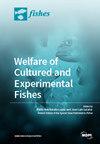Influence of Feeding, Temperature and Photoperiod on Purple Sea Urchin (Paracentrotus lividus) Gonad Development
IF 2.1
3区 农林科学
Q2 FISHERIES
引用次数: 0
Abstract
Understanding and controlling reproductive cycles and gonad maturation in cultivated species are crucial in aquaculture. The sea urchin Paracentrotus lividus, known for its edible gonads, requires careful maturation control for both reproduction and commercialization. This study explores the impact of temperature, photoperiod, and diet on gonad development to enhance year-round aquaculture practices. Using two independent cultivation systems, we manipulated environmental conditions to mimic different seasons. Sea urchins were exposed to natural or manipulated temperature and photoperiod conditions and fed either natural (Ulva spp.) or formulated diets. The gonadosomatic index (GI) and histological analysis were used to assess gonad development. The results revealed a clear correlation between environmental conditions, diet, and gonad maturation. Manipulated conditions accelerated maturation, with sea urchins showing advanced stages compared to natural conditions. Furthermore, sea urchins fed formulated diets exhibited higher GI values, indicating enhanced maturation. Histological analysis confirmed accelerated maturation, particularly in females. This study underscores the feasibility of controlling gonad maturation through environmental manipulation and diet, enabling year-round marketable gonad production. Providing formulated diets rich in polyunsaturated fatty acids, notably docosahexaenoic acid (DHA), enhances the commercial value of sea urchins. These findings optimize aquaculture practices for P. lividus, highlighting its adaptability to the maximal production of gonads throughout the year.喂食、温度和光周期对紫海胆(Paracentrotus lividus)性腺发育的影响
了解和控制养殖物种的生殖周期和性腺成熟对水产养殖至关重要。海胆(Paracentrotus lividus)以其可食用的性腺而闻名,它的繁殖和商业化都需要谨慎的成熟控制。本研究探讨了温度、光周期和饮食对性腺发育的影响,以加强全年水产养殖实践。我们使用两个独立的养殖系统,操纵环境条件来模拟不同的季节。海胆暴露在自然或人为控制的温度和光周期条件下,并喂食天然(莼菜属)或配方饲料。采用性腺发育指数(GI)和组织学分析来评估性腺发育情况。结果显示,环境条件、日粮和性腺成熟之间存在明显的相关性。人工条件加速了海胆的成熟,与自然条件相比,海胆的成熟期提前。此外,喂食配制食物的海胆显示出更高的 GI 值,表明其成熟度更高。组织学分析证实了海胆的加速成熟,尤其是雌性海胆。这项研究强调了通过环境控制和饮食来控制性腺成熟的可行性,从而实现全年生产适销性腺。提供富含多不饱和脂肪酸(尤其是二十二碳六烯酸(DHA))的配方日粮可提高海胆的商业价值。这些发现优化了 P. lividus 的水产养殖方法,突出了其全年性腺最大产量的适应性。
本文章由计算机程序翻译,如有差异,请以英文原文为准。
求助全文
约1分钟内获得全文
求助全文
文献相关原料
| 公司名称 | 产品信息 | 采购帮参考价格 |
|---|

 求助内容:
求助内容: 应助结果提醒方式:
应助结果提醒方式:


